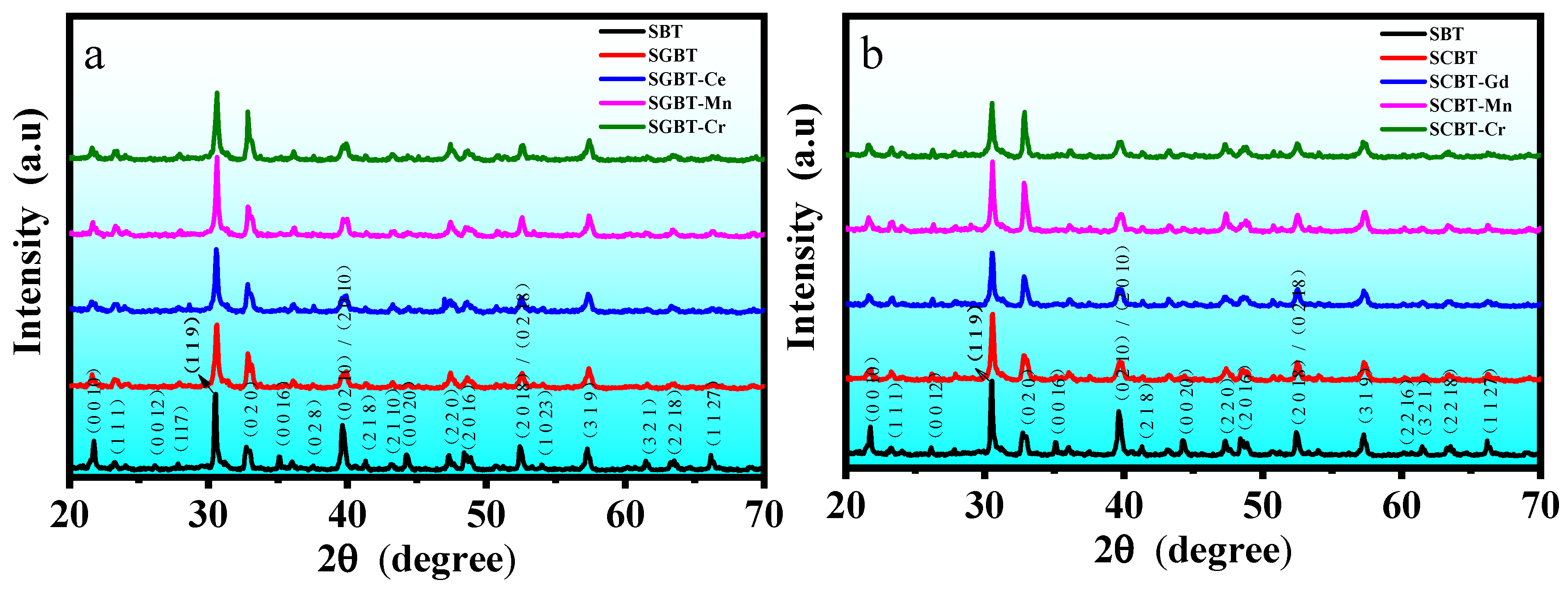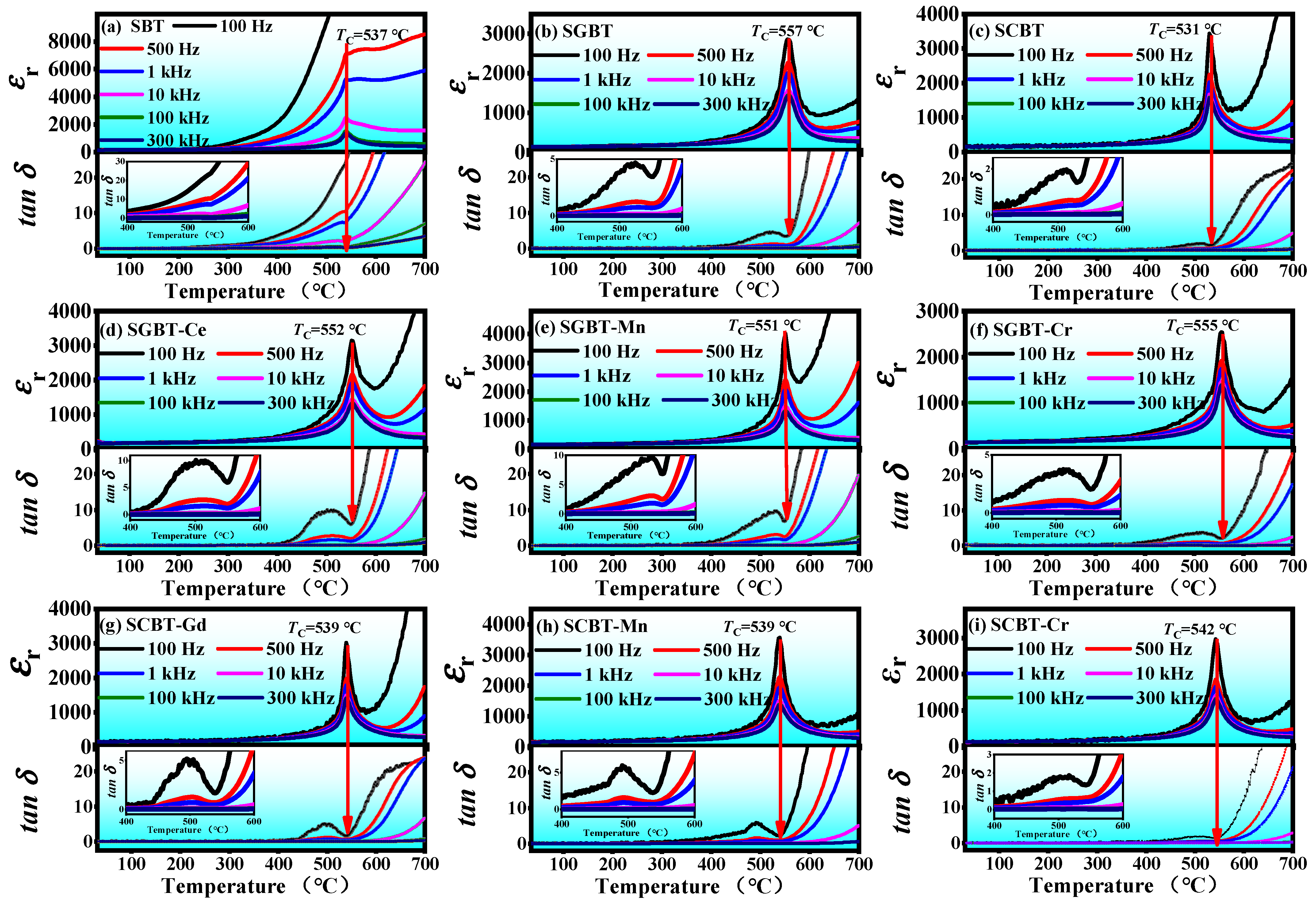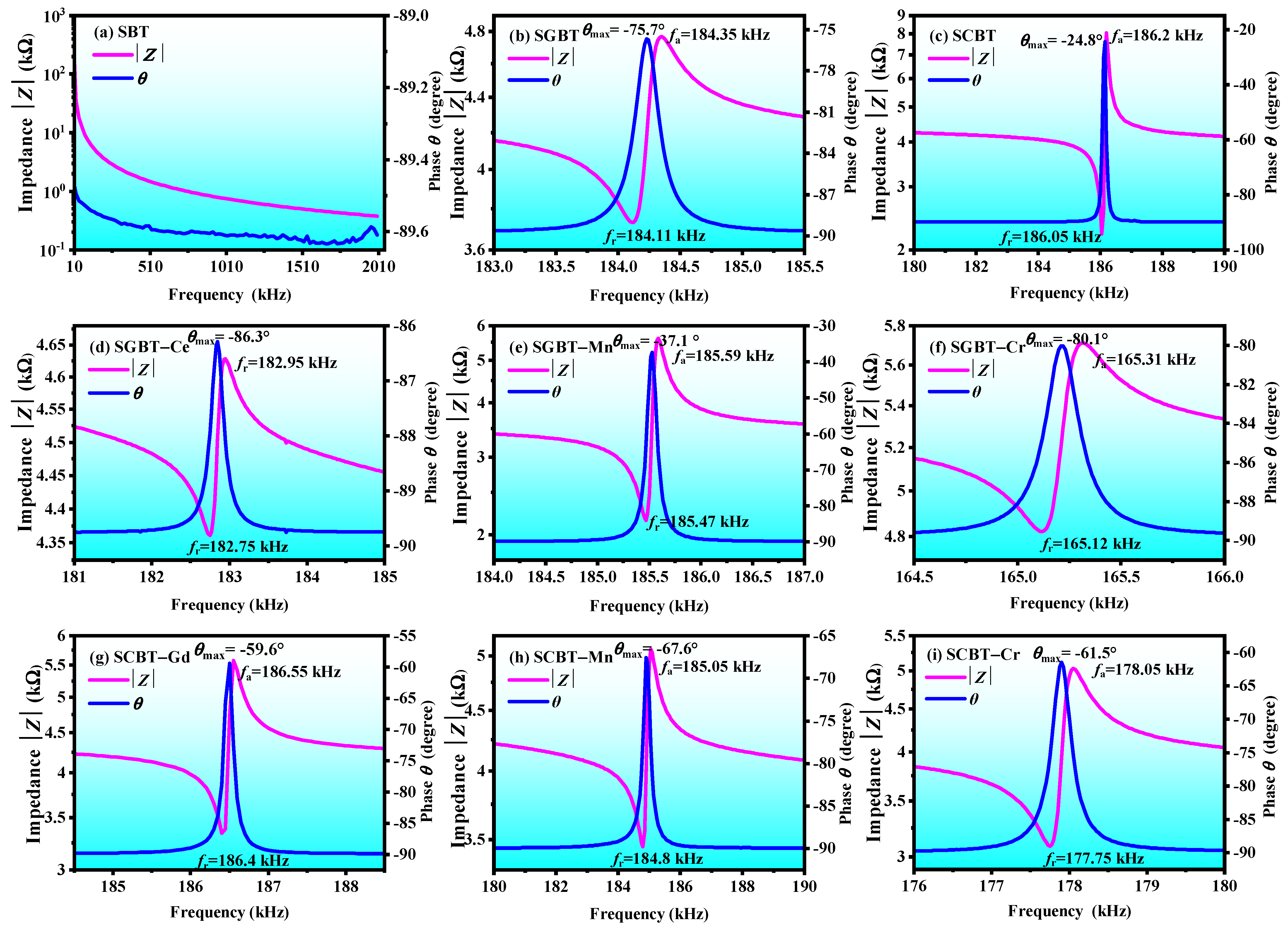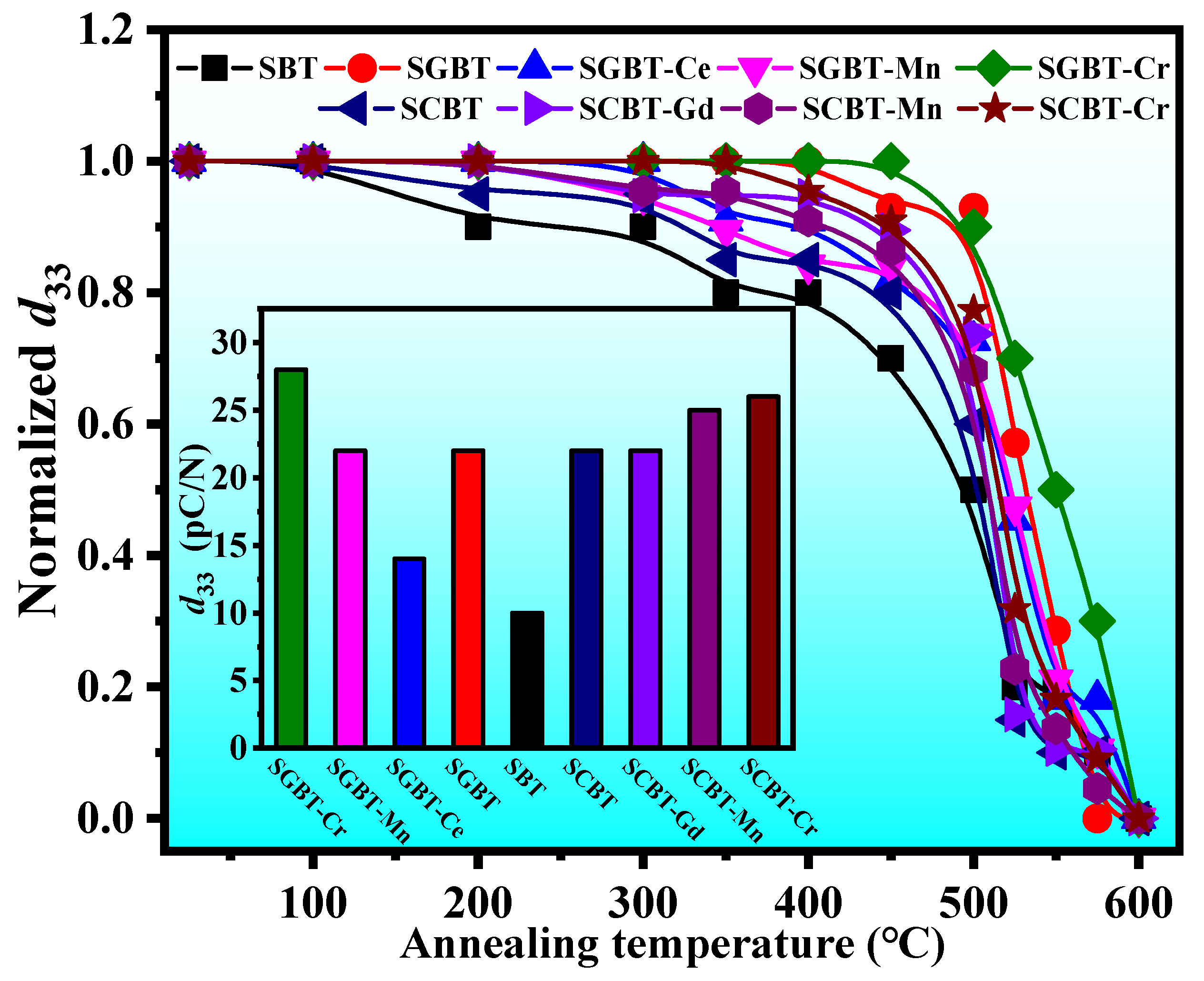Effects of Oxide Additives on the Phase Structures and Electrical Properties of SrBi4Ti4O15 High-Temperature Piezoelectric Ceramics
Abstract
:1. Introduction
2. Materials and Methods
2.1. Sample Preparation
2.2. Sample Characterization
3. Results and Discussion
3.1. Phase Structure of Ceramics
3.2. Dielectric Properties of Ceramics
3.3. Electro-Mechanical Coupling Property
3.4. Lower Limiting Frequency
3.5. Piezoelectric Properties
4. Conclusions
Author Contributions
Funding
Institutional Review Board Statement
Informed Consent Statement
Data Availability Statement
Conflicts of Interest
References
- Ali, F.; Raza, W.; Li, X.; Gul, H.; Kim, K.H. Piezoelectric energy harvesters for biomedical applications. Nano Energy 2019, 57, 879–902. [Google Scholar] [CrossRef]
- Song, K.; Zhao, R.; Wang, Z.L.; Yang, Y. Conjuncted pyro-piezoelectric effect for self-powered simultaneous temperature and pressure sensing. Adv. Mater. 2019, 31, 1902831. [Google Scholar] [CrossRef] [PubMed]
- Sahu, M.; Hajra, S.; Lee, K.; Deepti, P.L.; Mistewicz, K.; Kim, H.J. Piezoelectric nanogenerator based on lead-free flexible PVDF-barium titanate composite films for driving low power electronics. Crystals 2021, 11, 85. [Google Scholar] [CrossRef]
- Kim, K.; Zhang, S.; Salazar, G.; Jiang, X. Design, fabrication and characterization of high temperature piezoelectric vibration sensor using YCOB crystals. Sens. Actuators A Phys. 2012, 178, 40–48. [Google Scholar] [CrossRef]
- Parks, D.A.; Zhang, S.; Tittmann, B.R. High-temperature (>500 °C) ultrasonic transducers: An experimental comparison among three candidate piezoelectric materials. IEEE Trans. Ultrason. Ferroelectr. Freq. Control 2013, 60, 1010–1015. [Google Scholar] [CrossRef] [PubMed]
- Shrout, T.R.; Zhang, S.J. Lead-free piezoelectric ceramics: Alternatives for PZT? J. Electroceram. 2007, 19, 113–126. [Google Scholar] [CrossRef]
- Glaum, J.; Hoffman, M. Electric fatigue of lead-free piezoelectric materials. J. Am. Ceram. Soc. 2014, 97, 665–680. [Google Scholar] [CrossRef]
- Vázquez-Rodríguez, M.; Jiménez, F.J.; Pardo, L.; Ochoa, P.; González, A.M.; de Frutos, J. A new prospect in road traffic energy harvesting using lead-free piezoceramics. Materials 2019, 12, 3725. [Google Scholar] [CrossRef] [Green Version]
- De Araujo, A.P.; Cuchiaro, J.D.; Mcmillan, L.D.; Scott, M.C.; Scott, J.F. Fatigue-free ferroelectric capacitors with platinum electrodes. Nature 1995, 374, 627–629. [Google Scholar] [CrossRef]
- Zhang, L.; Wang, W.; Zhou, L.; Xu, H. Bi2WO6 nano- and microstructures: Shape control and associated visible-light-driven photocatalytic activities. Small 2010, 3, 1618–1625. [Google Scholar] [CrossRef]
- Wolfe, R.W.; Newnham, R.E.; Smithf, D.K.; Kay, M.I. Crystal structure of Bi3TiNbO9. Ferroelectrics 1972, 3, 1–7. [Google Scholar] [CrossRef]
- Chen, Y.; Liang, D.; Wang, Q.; Zhu, J. Microstructures, dielectric, and piezoelectric properties of W/Cr co-doped Bi4Ti3O12 ceramics. J. Appl. Phys. 2014, 116, 853. [Google Scholar] [CrossRef]
- Zhang, S.T.; Sun, B.; Yang, B. SrBi4Ti4O15 thin films of Ti containing bismuth-layered-ferroelectrics prepared by pulsed laser deposition. Mater. Lett. 2001, 47, 334–338. [Google Scholar] [CrossRef]
- Ferrer, P.; Algueró, M.; Iglesias, J.E.; Castro, A. Processing and dielectric properties of Bi4Srn−3TinO3n+3 (n = 3, 4 and 5) ceramics obtained from mechanochemically activated precursors. J. Eur. Ceram. Soc. 2007, 27, 3641–3645. [Google Scholar] [CrossRef]
- Stevenson, T.; Martin, D.G.; Cowin, P.I.; Blumfield, A.; Bell, A.J.; Comyn, T.P.; Weaver, P.M. Piezoelectric materials for high temperature transducers and actuators. J. Mater. Sci. Mater. Electron. 2015, 26, 9256–9267. [Google Scholar] [CrossRef] [Green Version]
- Nalini, G.; Row, T. Structure determination at room temperature and phase transition studies above Tc in ABi4Ti4O15 (A = Ba, Sr or Pb). Bull. Mater. Sci. 2002, 25, 275–281. [Google Scholar] [CrossRef] [Green Version]
- Nayak, P.; Badapanda, T.; Panigrahi, S. Dielectric, ferroelectric and conduction behavior of tungsten modified SrBi4Ti4O15 ceramic. J. Mater. Sci. Mater. Electron. 2016, 27, 1217–1226. [Google Scholar] [CrossRef]
- Ramana, E.V.; Graca, M.P.F.; Valente, M.A.; Sankaram, T.B. Improved ferroelectric and pyroelectric properties of Pb-doped SrBi4Ti4O15 ceramics for high temperature applications. J. Alloys Compd. 2014, 583, 198–205. [Google Scholar] [CrossRef]
- Rajashekhar, G.; Sreekanth, T.; James, A.R.; Ravi Kiran, U.; Sarah, P. Dielectric properties of sodium and neodymium substitute to A-Site SrBi4Ti4O15 ceramics. Ferroelectrics 2020, 558, 79–91. [Google Scholar] [CrossRef]
- Yu, L.; Hao, J.; Xu, Z.; Li, W.; Chu, R. Reddish orange-emitting and improved electrical properties of Sm2O3-doped SrBi4Ti4O15 multifunctional ceramics. J. Mater. Sci. Mater. Electron. 2017, 28, 16341–16347. [Google Scholar] [CrossRef]
- Nayak, P.; Badapanda, T.; Panigrahi, S. Dielectric and ferroelectric properties of Lanthanum modified SrBi4Ti4O15 ceramics. Mater. Lett. 2016, 172, 32–35. [Google Scholar] [CrossRef]
- Nayak, P.; Badapanda, T.; Singh, A.K.; Panigrahi, S. Possible relaxation and conduction mechanism in W6+ doped SrBi4Ti4O15 ceramic. Ceram. Int. 2017, 43, 4527–4535. [Google Scholar] [CrossRef]
- Wang, Q.; Cao, Z.P.; Wang, C.M.; Fu, Q.W.; Yin, D.F.; Tian, H.H. Thermal stabilities of electromechanical properties in cobalt-modified strontium bismuth titanate (SrBi4Ti4O15). J. Alloys Compd. 2016, 674, 37–43. [Google Scholar] [CrossRef]
- Hua, H.; Liu, H.; Ouyang, S. Structure and ferroelectric property of Nb-doped SrBi4Ti4O15 ceramics. J. Electroceram. 2009, 22, 357–362. [Google Scholar]
- Cao, Z.P.; Wang, C.M.; Lau, K.; Wang, Q.; Fu, Q.W.; Tian, H.H.; Yin, D.F. Large enhancement of piezoelectric properties in Mn-modified SrBi4Ti4O15 and its thermal stabilities at elevated temperatures. Ceram. Int. 2016, 42, 11619–11625. [Google Scholar] [CrossRef]
- Zhao, T.L.; Wang, C.M.; Wang, C.L.; Wang, Y.M.; Dong, S. Enhanced piezoelectric properties and excellent thermal stabilities of cobalt-modified Aurivillius-type calcium bismuth titanate (CaBi4Ti4O15). Mater. Sci. Eng. B 2015, 201, 51–56. [Google Scholar] [CrossRef]
- Rajashekhar, G.; Sreekanth, T.; Ravikiran, U.; Sarah, P. Dielectric properties of Na and Pr doped SrBi4Ti4O15 ceramics. Mater. Today Proc. 2020, 33, 5467–5470. [Google Scholar] [CrossRef]
- Du, H.; Ma, C.; Ma, W.; Wang, H. Microstructure evolution and dielectric properties of Ce-doped SrBi4Ti4O15 ceramics synthesized via glycine-nitrate process. Process. Appl. Ceram. 2018, 12, 303–312. [Google Scholar] [CrossRef] [Green Version]
- Liang, C.K.; Long, W. Microstructure and properties of Cr2O3-doped ternary lead zirconate titanate ceramics. J. Am. Ceram. Soc. 2010, 76, 2023–2026. [Google Scholar] [CrossRef]
- Wang, C.M.; Wang, J.F. High performance Aurivillius phase sodium-potassium bismuth titanate lead-free piezoelectric ceramics with lithium and cerium modification. Appl. Phys. Lett. 2006, 89, 1804. [Google Scholar] [CrossRef]
- Chen, Y.; Xie, S.; Wang, Q.; Zhu, J. Influence of Cr2O3 additive and sintering temperature on the structural characteristics and piezoelectric properties of Bi4Ti2.95W0.05O12.05 Aurivillius ceramics. Prog. Nat. Sci. Mater. Int. 2016, 26, 572–578. [Google Scholar] [CrossRef]
- Newnham, R.E. Cation ordering in Na0.5Bi4.5Ti4O15. Mater. Res. Bull. 1967, 2, 1041–1044. [Google Scholar] [CrossRef]
- Chen, Y.; Pen, Z.; Wang, Q.; Zhu, J. Crystalline structure, ferroelectric properties, and electrical conduction characteristics of W/Cr co-doped Bi4Ti3O12 ceramics. J. Alloys Compd. 2014, 612, 120–125. [Google Scholar] [CrossRef]
- Chen, Y.; Xu, J.; Xie, S.; Tan, Z.; Nie, R.; Guan, Z.; Wang, Q.; Zhu, J. Ion Doping effects on the lattice distortion and interlayer mismatch of aurivillius-type bismuth titanate compounds. Materials 2018, 11, 821. [Google Scholar] [CrossRef] [PubMed] [Green Version]
- Kumar, S.; Varma, K. Structural, dielectric and ferroelectric properties of four-layer Aurivillius phase Na0.5La0.5Bi4Ti4O15. Mater. Sci. Eng. B 2010, 172, 177–182. [Google Scholar] [CrossRef]
- Shulman, H.S.; Damjanovic, D.; Setter, N. Niobium doping and dielectric anomalies in bismuth titanate. J. Am. Ceram. Soc. 2010, 83, 528–532. [Google Scholar] [CrossRef]
- Chen, Y.; Xie, S.; Wang, H.; Chen, Q.; Wang, Q.; Zhu, J.; Guan, Z. Dielectric abnormality and ferroelectric asymmetry in W/Cr co-doped Bi4Ti3O12 ceramics based on the effect of defect dipoles. J. Alloys Compd. 2017, 696, 746–753. [Google Scholar] [CrossRef]
- Chen, Y.; Wang, S.; Zhou, H.; Xu, Q.; Wang, Q.; Zhu, J. A systematic analysis of the radial resonance frequency spectra of the PZT-based (Zr/Ti = 52/48) piezoceramic thin disks. J. Adv. Ceram. 2020, 9, 380–392. [Google Scholar] [CrossRef] [Green Version]
- Hou, Y.D.; Lu, P.X.; Zhu, M.K.; Song, X.M.; Tang, J.L.; Wang, B.; Yan, H. Effect of Cr2O3 addition on the structure and electrical properties of Pb((Zn1/3Nb2/3)0.20(Zr0.50Ti0.50)0.80)O3 ceramics. Mater. Sci. Eng. B 2005, 116, 104–108. [Google Scholar] [CrossRef]
- Turner, R.C.; Fuierer, P.A.; Newnham, R.E.; Shrout, T.R. Materials for high-temperature acoustic and vibration sensors—A review. Appl. Acoust. 1994, 41, 299–324. [Google Scholar] [CrossRef]
- Chun, P. Influence of mobile space charges on the ferroelectric properties of (K0.50Na0.50)2(Sr0.75Ba0.25)4Nb10O30 ceramics. J. Appl. Phys. 1997, 82, 2528–2531. [Google Scholar]






| Compositions | SBT | SGBT | SGBT-Ce | SGBT-Mn | SGBT-Cr | SCBT | SCBT-Gd | SCBT-Mn | SCBT-Cr | |
|---|---|---|---|---|---|---|---|---|---|---|
| Orthorhombic, Bb21m | ||||||||||
| a (Å) | 5.43177 | 5.42744 | 5.42855 | 5.42849 | 5.42483 | 5.42807 | 5.42893 | 5.42653 | 5.42411 | |
| b (Å) | 5.43718 | 5.43507 | 5.43741 | 5.43693 | 5.43767 | 5.43818 | 5.43877 | 5.43772 | 5.43598 | |
| c (Å) | 40.95524 | 40.93938 | 40.92796 | 40.88468 | 40.89918 | 40.95129 | 40.9501 | 40.95103 | 40.93853 | |
| V (Å3) | 1209.54 | 1207.65 | 1208.08 | 1206.68 | 1206.46 | 1208.83 | 1209.12 | 1208.38 | 1207.85 | |
| b/a | 1.0010 | 1.0014 | 1.0016 | 1.00155 | 1.0024 | 1.0019 | 1.0018 | 1.0020 | 1.0022 | |
| Compositions | SBT | SGBT | SGBT-Ce | SGBT-Mn | SGBT-Cr | SCBT | SCBT-Gd | SCBT-Mn | SCBT-Cr |
|---|---|---|---|---|---|---|---|---|---|
| ρtheoretic (g/cm3) | 7.4456 | 7.4667 | 7.4614 | 7.4724 | 7.4522 | 7.441 | 7.4292 | 7.446 | 7.4367 |
| ρactual (g/cm3) | 7.0598 | 6.8822 | 7.137 | 7.0692 | 6.3155 | 7.1173 | 7.08528 | 7.2209 | 6.5354 |
| ρrelative (%) | 94.8 | 92.2 | 95.7 | 95.7 | 84.7 | 95.6 | 95.4 | 97 | 87.8 |
| Compositions | SGBT | SGBT-Ce | SGBT-Mn | SGBT-Cr | SCBT | SCBT-Gd | SCBT-Mn | SCBT-Cr |
|---|---|---|---|---|---|---|---|---|
| kp (%) | 5.72 | 5.2 | 4.03 | 6.35 | 3.7 | 4.5 | 5.8 | 6.51 |
| Qm | 423 | 465 | 1240 | 355 | 1885 | 787 | 443 | 374 |
| Np (Hz·m) | 2655 | 2745 | 2711 | 2481 | 2751 | 2740 | 2694 | 2613 |
| Compositions | εr (1 kHz) | tan δ (1 kHz) | Tc (°C) | d33 (pC/N) |
|---|---|---|---|---|
| SBT | 152 | 0.9 | 537 | 10 |
| SGBT | 145 | 0.4 | 557 | 22 |
| SGBT-Ce | 168 | 0.4 | 552 | 14 |
| SGBT-Mn | 156 | 0.3 | 551 | 22 |
| SGBT-Cr | 156 | 0.3 | 555 | 28 |
| SCBT | 175 | 0.1 | 531 | 22 |
| SCBT-Gd | 169 | 0.2 | 539 | 22 |
| SCBT-Mn | 176 | 0.2 | 539 | 24 |
| SCBT-Cr | 124 | 0.3 | 542 | 26 |
| SBT-Sm [20] | 220 | 2.0 | 520 | 20 |
| SBT-3Co [23] | 200 | 0.6 | 528 | 28 |
| SBT-4Mn [25] | 180 | 0.8 | 530 | 30 |
Publisher’s Note: MDPI stays neutral with regard to jurisdictional claims in published maps and institutional affiliations. |
© 2021 by the authors. Licensee MDPI, Basel, Switzerland. This article is an open access article distributed under the terms and conditions of the Creative Commons Attribution (CC BY) license (https://creativecommons.org/licenses/by/4.0/).
Share and Cite
Wang, S.; Zhou, H.; Wu, D.; Li, L.; Chen, Y. Effects of Oxide Additives on the Phase Structures and Electrical Properties of SrBi4Ti4O15 High-Temperature Piezoelectric Ceramics. Materials 2021, 14, 6227. https://doi.org/10.3390/ma14206227
Wang S, Zhou H, Wu D, Li L, Chen Y. Effects of Oxide Additives on the Phase Structures and Electrical Properties of SrBi4Ti4O15 High-Temperature Piezoelectric Ceramics. Materials. 2021; 14(20):6227. https://doi.org/10.3390/ma14206227
Chicago/Turabian StyleWang, Shaozhao, Huajiang Zhou, Daowen Wu, Lang Li, and Yu Chen. 2021. "Effects of Oxide Additives on the Phase Structures and Electrical Properties of SrBi4Ti4O15 High-Temperature Piezoelectric Ceramics" Materials 14, no. 20: 6227. https://doi.org/10.3390/ma14206227
APA StyleWang, S., Zhou, H., Wu, D., Li, L., & Chen, Y. (2021). Effects of Oxide Additives on the Phase Structures and Electrical Properties of SrBi4Ti4O15 High-Temperature Piezoelectric Ceramics. Materials, 14(20), 6227. https://doi.org/10.3390/ma14206227








